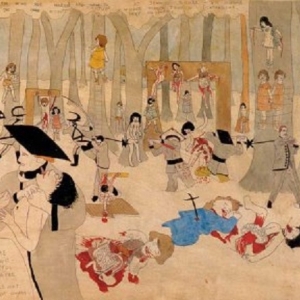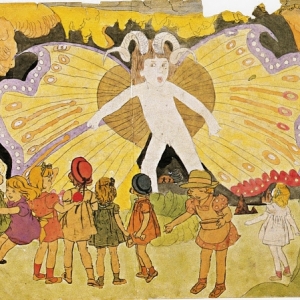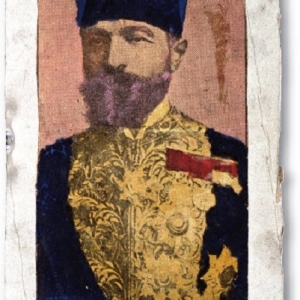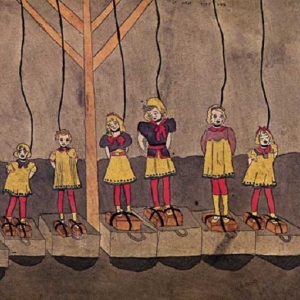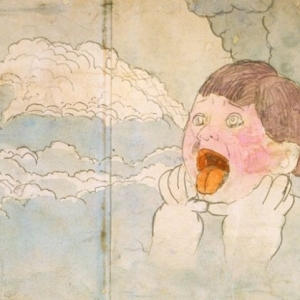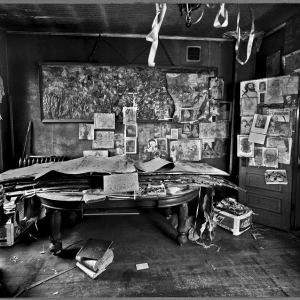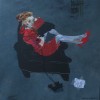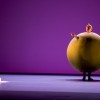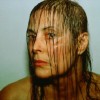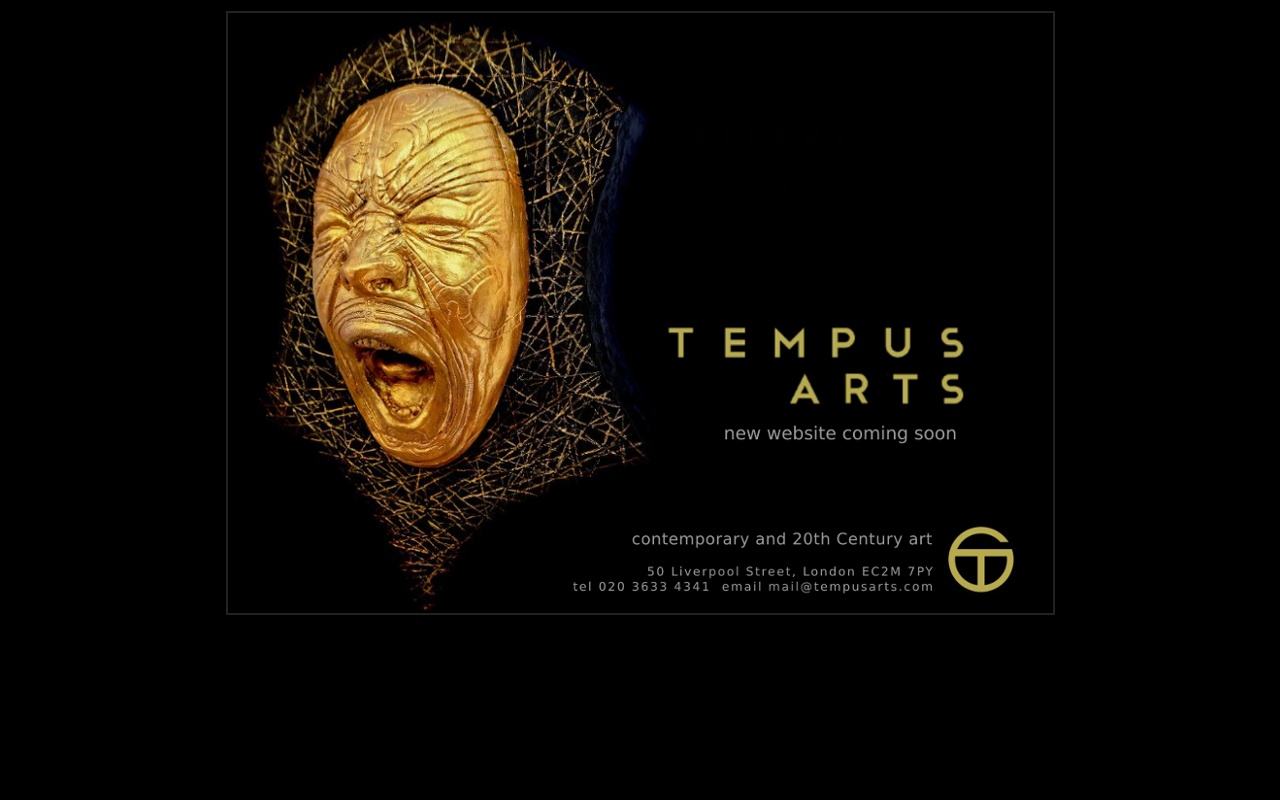More often than not, outsider artists demonstrate extreme mental states unconventional ideas, or extravagant fantasy worlds. The French artist Jean Dubuffet created the phrase Art Brut, which means ‘Raw Art,’ which is basically just another definition to describe art made by the eccentric. Outsider art is considered to be deeply personal to the maker, conveying inner torment and the great depths of their imagination. It is said that they can do this as they have not been trained in painting; their art is just a natural way of expressing themselves, which makes the process more special and fascinating.
An artist who created a whole new reality for himself that he used to escape the unsettling realms of society was Henry Darger, a well know Outsider Artist. His art, like many other works of artists expressing themselves in this way, was only discovered after his death. Darger was born in 1892; he was a recluse and was often seen wandering miles from home, in the nearby Catholic Church or working as a cleaner in local hospitals. After his death, as his landlord began to clean out Darger’s room he discovered 5,084 handwritten pages entitled “The History of my Life.” Also discovered were around 15,000 typewritten pages entitled “In the realms of the Unreal.” Along with the fiction, three huge bound volumes of illustrations and several hundred paintings of which many that were over twelve feet long were also found.
The boundaries between reality and the fictional world became unclear for Darger, and as he got older the disappointment of life and the knowledge of his many painful experiences including bullying and psychiatric wards pushed him to create a different world for himself: one where he made up the rules. This world he created was called “In the Realms of the Unreal.” It was his masterpiece, where he brought to life the reality inside his head, first through words, then through imagery. “The Realms” came to retain a much greater significance in Darger’s life, emotionally, intellectually and possibly even perceptually more than the real world was able to. Emotionally, Darger remained a child. In “The History of my Life” he wrote: “Do you believe it, unlike most children, I hated to see the day come when I will be grown up. I never wanted to. I wished to be young always. I am grown up now and an old lame man, darn it.” As a child Darger was bullied and called “crazy” by his classmates. He was removed from his home and placed permanently in an institution for disturbed children. The fact that he was put in an institution by the adults made Darger perceive that they believed the cruel remarks of the other children. This may have had a big impact in the way he observed adults, rendering them the evil ones within his writing and influencing his desire to stay young. Because of this, Darger only felt at ease with children, which is why the heroes of his fantasy world were seven little girls: the Vivian sisters. As put deftly by Canadian art historian and psychotherapist John MacGregor: “his little girls never grew up, nor did he.”
This world was dangerous and frightening, and in it the children would struggle against the scheming of the wicked adults. A running theme within the novel is the disturbing sexual fantasies and the horrific acts of evil which it seems Darger was obsessed with. A regular occurrence within his writing was the torture and murder of innocent children, relayed in distressing detail. The children were whipped, burned or boiled alive, being tied to trees and left to freeze or buried up to their necks and left to die. More commonly, the children are hanged, disembowelled, cut into pieces or crucified. The detail of his violent scenes is illustrated within the following extract: “Scores upon scores of poor children were cut to pieces, after being strangled to death, and even their organs were hung on trees. Children were forced to swallow the sliced fragments of dead children’s hearts. Nearly three quarters of the number of children who were massacred died first by strangulation, their eyes and protruding tongues were extracted, their bodies opened and their entrails pulled out, and their bodies hacked and torn and left lying in that condition on the streets and pavements.
Blood dripping corpses were fairly hung from windows or stuck on posts and pikes.” The little girls were mainly drawn nude, and with male genitals. This may be attributed to Darger’s lack of knowledge about the female physique, and so instead drew what he knew. These drawings can be compared to Baker’s Diary Drawings as they both display a childish quality. Baker’s drawings show the truth about her emotions, but there is a fairy tale look to some entries. “My Psychotherapist: Day 165,” shows the professional as a dangerous creature, almost like the big bad wolf in the classic children’s tale “The Three Little Pigs.” The psychotherapist is much larger than Baker, holding weapons and with long, threatening finger nails. There is a clear divide between the professionals deemed evil, and Baker herself. Within Darger’s drawings there is also an obvious divide, this time between adults and children, with all of the adults being the malicious villains and the children being the heroes. John MacGregor wrote, “Only now, after he is gone, is the richness of his being unfolding in the world, in ways and to an extent he could never have imagined – and never desired.” MacGregor also describes Darger’s creative process as “near hallucinatory intensity” which further pushes the theory that he was indeed an Outsider Artist due to mental extremities.
Darger was fixated with collecting images: his room littered with newspaper clippings, photos from magazines, religious clippings and illustrated books. He would cut out every picture that had even the smallest connection to his make believe world. The vast majority of his collection of images were of children, mainly little girls. He would study them all, building up an image for his Vivian sisters. Darger found the images useful in creating his fantasy world, altering photographs of landscapes and adding little bits here and there such as a train track and station. He would find images of military men and to add them to his stories, paint their uniforms in bright colours. Black and white newspaper photographs were repainted in reds, yellows and blues. One was even given a bright pink beard and christened General Greatheart. For the huge battle scenes from “The Reals,” Darger relied heavily on borrowed images. However, his inability to handle paint deceived him and he often destroyed the original image, complicating the subject which was all but lost beneath the bright blotches of colourful paint. To overcome this problem he would write in great detail the narrative which could not be depicted in the painting.
Another technique Darger used was Illusionistic collage, a method he may have invented himself. It enabled him to approach the obsessive explanatory tone typical of his writing style. Darger created his largest works using this system, an important example being “A host of Calverinians,” a theatrically staged war photograph where large groups of soldiers have been arranged to illustrate his own perception of war. The further back the soldiers were, the smaller the cut outs were, showing that Darger was aware of perspective and scale. Once creating this collage of depth, he would use water colours to brighten the image: greens, browns, and yellows for the landscape and bright reds for the soldier’s uniforms. The military procession of colours pulled the image together, making it seem like an original.
Darger experimented further with collage, finding old photographs and newspaper images from as far back as his father’s childhood. Within his room, a heavily varnished piece of cardboard with pictures of little girls glued to it was also found. Originally black and white images, Darger had, like many other times before, painted the clothing in bright colours, obscuring the detail but making sure the innocence in the children’s faces stayed strong. He adapted the images to his own ideas, and made them his portraits of the seven Vivian sisters. Underneath each picture he wrote a short description of the child’s character. The description of Catherine Vivian was: “Catherian Vivian was reported killed several times, but she was not. Yet sometime during the early part of the Glandco-Abbieannian War, her reported death was much disputed and found to be untrue as some else person was killed instead. Some at first said Abbieannians shot her to death by mistake, but in reality Glandelinians often tried to do it, but did not succeed. She is still very much alive.”
Along with the thousands of images taken from newspapers and magazines which were transformed into pictures from his make believe reality, there were many small drawings, most were studies of the human figure. Numerous images were direct tracings of other images, as Darger traced all of his work. He was not confident in his ability to sketch the human form and so ‘borrowed’ other pictures to work from. Colouring books were extremely important to Darger: the simplified outlines, the bold shapes and heavy lines added to the innocent ideas of ‘The Realms.’ Other sources that helped Darger to bring his writing to life were comic strips, his favourite being “Little Annie Rooney.” He was most interested in the stories that portrayed little girls as the heroines, co-operating on equal terms with the adults. Darger also watched many cartoons and read comic books aimed for children. He had a childlike sense of humour and enjoyed the humanized animals created by Walt Disney. Darger wanted to incorporate this into his writing but the troubled world of “The Realms” was not the place for such animation. He overcame this problem by creating ghostly presences in the clouds: “The blues and greys were very beautiful even though it was all smoke, and the two brave little girls noticed that seemingly on the cloud banksseemed to sit or recline fleecy shadowy forms almost like some strange beings of another world.” This could be down to the anxieties he faced as a boy, and more importantly, his fear of ghosts.
Most of the clouds are cartoon characters traced from his mass collection of images, and it is interesting that he feels humour should be injected into the illustrations even though the story is of such despair and pain. This can be related to the work of Bobby Baker. Although her work is primarily about her struggle with mental illness, she adds humour to the work as a mode of communication. This can make the viewer uncomfortable, as mental illness is a subject that people are often not educated in and try to stay clear of. The fact that these artists who suffer from a form of mental illness are poking fun at it can be disconcerting. The viewer doesn’t know whether to laugh along or stay serious. This can also relate to Hannah Wilke, as humour was present within her work all throughout her life, whether it was making fun of her sexuality and the way women are perceived, or about her cancer. Wilke’s partner Donald Goddard said, “She wasn’t a joke teller, but she was extremely funny and clever. I think you can see it in the titles of her work. The word play is extraordinary at times. She just saw things that way.”
Darger did not create his work for public viewing, and wrote at the beginning of his story: “All the gold in the gold mines, all the silver in the world, nay, all the world, cannot buy these pictures from me. Vengeance, thee vengeance on those who steals or destroys them.” However, the suffering he went through and his unconventional thought processes are made plain to see. The fact he could live within a different reality and use his imagination to escape there each day shows that the real world was an agonizing place for him to live.
Being a recluse, Darger never had the opportunity to communicate how he felt about his situation to an audience. Darger’s art work could therefore be seen as a way for him to cope with life, with no concern as to how the audience may interpret it. However, the audience gains understanding of Darger’s situation by looking through his illustrations and reading his words once his work was posthumously published. Although Darger did not produce his work with this intention, audiences are still able to engage with it. This differs from both Wilke and Baker, as these two artists made work specifically for an audience. They created art to portray the illnesses they were going through and the experiences they faced. Their art work communicated how illness affected and changed their ideas of their own reality, and attempts to place us in their situation so we can better understand how they feel.
Whilst Wilke, Baker and Darger have all explored illness within their work, they have used different media to communicate their experiences with dealing and living with illness. Wilke uses photography to show realistically how the cancer destroyed her body, which shocked the audience because it was so real and graphic. It could be argued that audience members who have had experience with cancer could easily relate to the images due to its raw truthfulness. As her work was primarily photography, people who had not had the illness could also relate to the work as it appeared a factual document of how cancer affects the body. Baker and Darger differ from this as the majority of their works were drawings, and so it could be more difficult for viewer to extract and understand what artist was trying to portray.
Wilke’s work is very forthright and shows exactly what it is: there is no hiding or double meanings within her images. She wants to show how cancer is destroying her body, and how the audience thinks differently when seeing the illness she has. Wilke still poses seductively, like she does in the photographs she took when she was well, however, due to her illness, the audience view these later works in a different light. Even though the stances are very similar to her early images, the audience knows she has cancer and so consider the work in another way: the effects of the cancer is now what they see first. Due to cancer being something a lot of people have had experience with, the audience may not understand why Wilke would want to live out the effects of such a terrible illness beneath the judgemental eyes of the public.
Baker also deals with a very taboo subject, using humor as a way to communicate her experience with having a mental illness. She converses with the audience in a way that pushed them to rethink their opinions on the subject. People may wonder why Baker mocks the illness and injects such humor into such a serious topic. After Baker’s performances it may become clear to the viewer that the reasons are so she can cope with a debilitating illness: art is Baker’s therapy. Her diary drawings also show humor but many also show a different side to Bakers work through her use of frightening and horrific imagery. The diary drawings were a private place for her to communicate her inner thoughts with health professionals that recently became available for the public to see. These drawings communicate how Baker really felt during her time within an institute, documenting her meetings with psychotherapists and interaction with other patients suffering from a mental illness.
Darger also used drawing as a way to help him cope with his life, making clear that the life that he led was just as shocking as the content of his work. The fact he lived as a recluse for most of his life and had the mental ability to create a whole other reality for himself is unbelievably sad. Society rejected him and his therapy was to use art as a way of coping. Some of Darger’s writing is very explicit, with horrendous descriptions appearing throughout his work that are illustrated just as shockingly. Although the work was never meant for the public, it is easy to see the torment Darger went through and the work communicates his inner thoughts, showing he has different cognitive processes to most. Darger’s writing is also important. The words communicate shocking scenes of torture and sexual frustrations in black and white, making it easier for the audience to see how he felt at the time. Art invites subjective responses, but here, there is only each word to understand, compounded by the impacts of his images.
All three artists communicate with the audience about living with illness and the side effects that come with that illness. Although Darger never intended to do so, he does express to the viewer how a life of solidarity affected him, and as he is now seen as an Outsider Artist the work suggests that he may have suffered from mental health problems. This is something that the audience would now bear in mind when viewing the work. Wilke shows in great detail how cancer decays the body and also the mind, depicting the horrific changes the body goes through as the disease advances to the public. The work lets the audience in on something that is often kept extremely private, educating them when they would never fully gain an understanding unless they were faced first hand with the illness. Baker also educates the audience on a subject many would never have an understanding of, showing the audience that is ok to not be so serious around the topic, and that people with mental health problems are still ‘normal’ and can still laugh at themselves. Like Darger, she kept her most private thoughts private, until realising her drawings may actually help other people with mental health problems. But as Darger was not alive to decide whether or not he wanted his work to become public, we must consider whether it is morally right for the audience to view it. Darger told us he wanted the work kept private but, unfortunately this request was not met. As put by the artist himself: “All the gold in the gold mines, all the silver in the world, nay, all the world, cannot buy these pictures from me. Vengeance, thee vengeance on those who steals or destroys them.”



